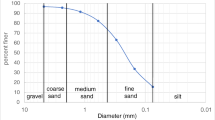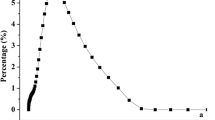Abstract
Purpose
Mineral dust pollution is a concern for human health due to the reaction of mineral particles in the organism and their role as pathogen carriers. Human activity generates unconsolidated sediments that become a dust source. This study investigates the effect of microbial growth on dust stabilization through aggregation in order to help alleviate this problem.
Materials and methods
Four representative potential dust sources (volcanic ash, carbonate, mine waste, and diatomaceous earth) and three organic nutrients (humic acids, glucose + peptone and yeast extract) were selected. We used the indigenous microbial communities in the mineral samples, rain and tap water. All experiments were carried out in Petri dishes, in moist conditions. The experiments were illuminated artificially for 12 h a day and control experiments were carried out in the dark.
Results and discussion
Biological growth occurred within a few days, and followed the same sequence (bacteria, fungi, and green algae) irrespective of rock type or nutrient. After weeks, the biological development was large and dominated by the algae. Bacteria and fungi developed in some control experiments. The microbial mats successfully aggregated the sediment and formed large patches that remained stable after complete drying. Tests to measure organic C content may indicate humic acid as the most efficient of the three nutrients. SEM observation showed intricate interlacing between mineral grains and microbial structures, and the predominance of large algal mats. Measurements of particle size in water using laser granulometry showed larger particles after the experiments, despite the aqueous medium having a disaggregating effect. Simulated wind erosion indicated the removal of lower proportions of the sediment in the experiments than in their controls.
Conclusions
Our results suggest that rapid stabilization of the surface of disaggregated sediments using microbial growth is feasible, the microbial mat remains biologically active in moist conditions and the dry sediment can be physically stable for a period of time unless disrupted mechanically. Algae have the maximum aggregating effect. This system of rapid stabilization appears to be equally feasible in sediments of very different mineralogical and chemical composition.





Similar content being viewed by others
References
Alimova A, Katz A, Steiner N, Rudolph E, Wei H, Steiner J, Gottlieb P (2009) Bacteria-clay interaction: structural changes in smectite induced during biofilm formation. Clay Clay Miner 57:205–212
Chantigny MH, Angers DA, Prevost D, Vezina LP, Chalifour FP (1997) Soil aggregation and fungal and bacterial biomass under annual and perennial cropping systems. Soil Sci Soc Am J 61:262–267
Chen L, Xie Z, Hu C, Li D, Wang G, Liu Y (2006) Man-made desert algal crusts as affected by environmental factors in Inner Mongolia, China. J Arid Environ 67(3):521–527
Gerbersdorf SU, Bittner R, Lubarsky H, Manz W, Paterson DM (2009) Microbial assemblages as ecosystem engineers of sediment stability. J Soils Sediments 9:640–652
Gregory PH (1973) The Microbiology of the Atmosphere, (2nd edn), Leonard Hill Books
Griffin DW (2005) Clouds of desert dust and microbiology. Microbiol Today 180–182
Griffin DW (2007) Atmospheric movement of microorganisms in clouds of desert dust and implications for human health. Clin Microbiol Rev 20:459–477
Hu C, Liu Y, Song L, Zhang D (2002) Effect of desert soil algae on the stabilization of fine sands. J Appl Phycol 144:281–292
Lynch JM, Elliot LF (1983) Aggregate stabilization of volcanic ash and soil during microbial degradation of straw. Appl Environ Microbiol 45:1398–1401
Martens DA, Frankenberger JWT (1992) Decomposition of bacterial polymers in soil and their influence on soil structure. Biol Fertil Soils 13:65–73
Puget P, Angers DA, Chenu C (1999) Nature of carbohydrates associated with water-stable aggregates of two cultivated soils. Soil Biol Biochem 31:55–63
Pye K (1987) Aeolian dust and dust deposits. Academic Press, New York
Ritz K, Young IM (2004) Interaction between soil structure and fungi. Mycologist 18(2):52–59
Sylvia DM, Fuhrmann JJ, Hartel PG, Zuberer DA (2005) Principles and applications of soil microbiology, 2nd edn. Prentice Hall, New Jersey
Tisdall JM, Smith SE, Rengasamy P (1997) Aggregation of soil by fungal hyphae. Aust J Soil Res 35:55–60
Visscher PT, Stolz JF (2005) Microbial mats as bioreactors: populations, processes, and products. Palaeoecology 219:87–100
Acknowledgments
We thank Ben Williamson for discussion of the experiments from the planning stage. We thank David Thornley for training in the use of the laser granulometer. Thanks also to Geoffrey Gadd, Xavier Querol, Teresa Moreno, and Allan Pentecost for discussion and helpful information, and to Sabine U. Gerbersdorf and an anonymous reviewer for their detailed comments and suggestions. This work was financed by an SIF award (2007) by the Natural History Museum in London and the Department of Mineralogy at the same Institution.
Author information
Authors and Affiliations
Corresponding author
Additional information
Responsible editor: Sabine Ulrike Gerbersdorf
Rights and permissions
About this article
Cite this article
Cuadros, J., Spiro, B., Dubbin, W. et al. Rapid microbial stabilization of unconsolidated sediment against wind erosion and dust generation. J Soils Sediments 10, 1415–1426 (2010). https://doi.org/10.1007/s11368-010-0273-8
Received:
Accepted:
Published:
Issue Date:
DOI: https://doi.org/10.1007/s11368-010-0273-8




